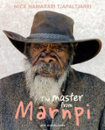AustLit
Latest Issues
AbstractHistoryArchive Description
'The master from Marnpi traces Namarari's journey as a child, survivor, stockman, traveller, artist, family leader, cultural advocate and community member through his life as a boy, adult and old man. This detailed and sensitive narration of Namarari's fascinating life in Australia's desert settlements yield broader insights into the lives of Aboriginal artists, the meaning of their art and the integral role of Aboriginal art centres in establishing and supporting the artist in the marketplace. The book traces the course of Namarari's life. It explores his childhood in the desert and his move to the mission and of Central Australian cattle stations from Marnpi and Ilpilli to Hermannsburg and on to Tempe Downs (1920s-1930s). it charts his adult life in the cross-cultural milieu of Central Australian settlements, such as Haasts Bluff and Papunya, west of Alice Springs (1940s-1960s), and uncovers his largely hidden roles of educator and family man from Papunya and Mount Liebig to Kintore and Nyunmanu (1970s-1990s). Original oral history interviews and catalogue raisonne research reveal the strong working relationship Namarari had with Papunya Tula Artists. The more than seventy paintings in The master from Marnpi highlight his exemplary art career (1971-1998). His relationships with key relatives, supporters and art advisors show Namarari to be an inventive hard-working artist and a humble man. Namarari is the only Wester Desert artist to win these significant awards: the National Aboriginal Art Award, the Alice Prize (co-winner) and the prestigious Red Ochre Award. If there had been an award for generous cross-cultural teacher he would have won that too. (Publication summary)
Publication Details of Only Known VersionEarliest 2 Known Versions of
Works about this Work
-
Fred Myers Review of Alec B. O’Halloran, The Master from Marnpi: Mick Namarari Tjapaltjarri, Pintupi Man, Papunya Tula Artist
2020
single work
review
— Appears in: Australian Journal of Biography and History , no. 4 2020; (p. 199-204)
— Review of The Master From Marnpi 2018 single work biography'Alec O’Halloran’s The Master from Marnpi has my mind jumping in many directions. It is a beautiful volume, a biography of the Pintupi man Mick Namarari Tjapaltjarri, self-produced, with extensive visual images. It is not published through a scholarly press, but it is an exemplary work of scholarship, of sourcing and citation, and it will not only be a fundamental piece of work for those interested in Indigenous Australian art but also, in my view, for many others with curiosity and interest in Indigenous life and history.' (Introduction)
-
Fred Myers Review of Alec B. O’Halloran, The Master from Marnpi: Mick Namarari Tjapaltjarri, Pintupi Man, Papunya Tula Artist
2020
single work
review
— Appears in: Australian Journal of Biography and History , no. 4 2020; (p. 199-204)
— Review of The Master From Marnpi 2018 single work biography'Alec O’Halloran’s The Master from Marnpi has my mind jumping in many directions. It is a beautiful volume, a biography of the Pintupi man Mick Namarari Tjapaltjarri, self-produced, with extensive visual images. It is not published through a scholarly press, but it is an exemplary work of scholarship, of sourcing and citation, and it will not only be a fundamental piece of work for those interested in Indigenous Australian art but also, in my view, for many others with curiosity and interest in Indigenous life and history.' (Introduction)
- Western Australia,
- Great Western Desert,




